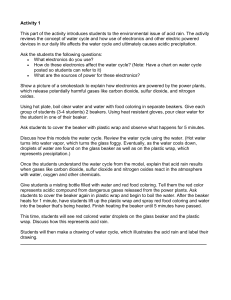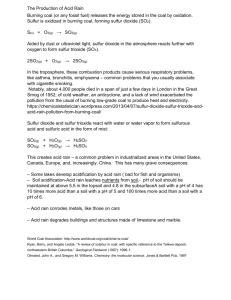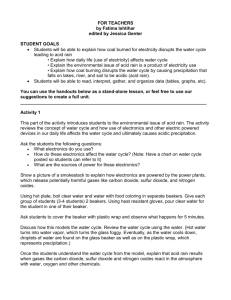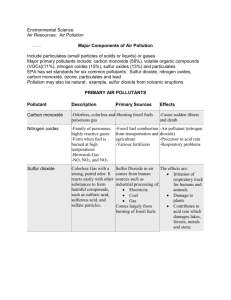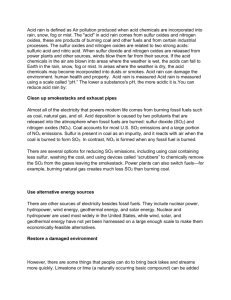Activity 1 This part of the activity introduces students to the
advertisement
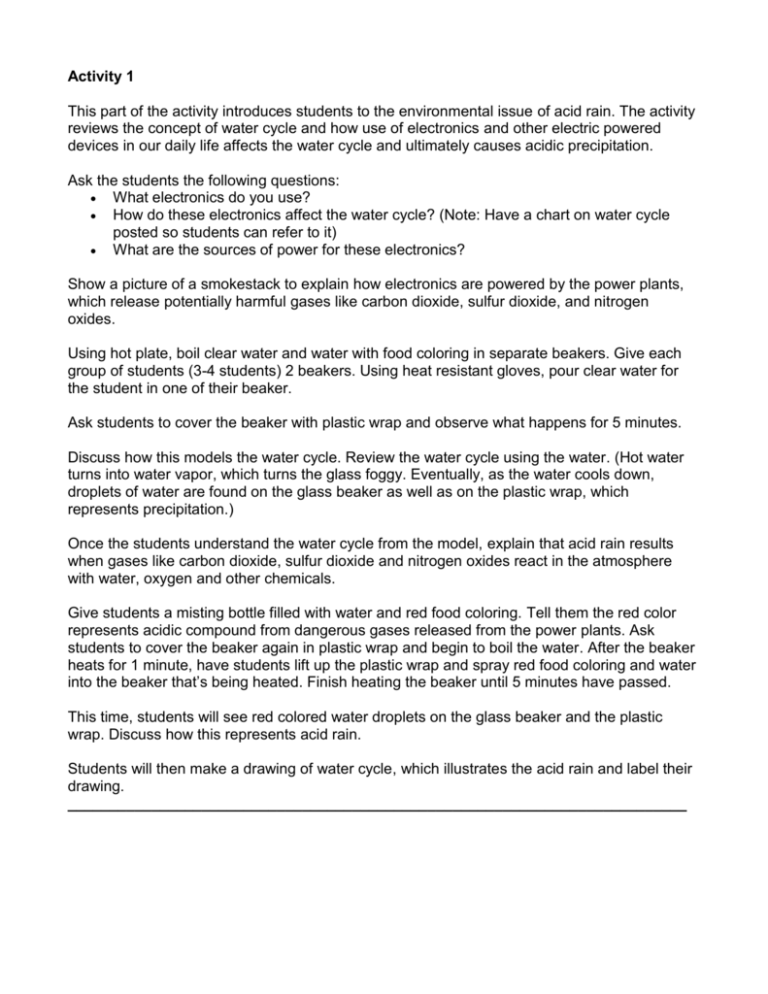
Activity 1 This part of the activity introduces students to the environmental issue of acid rain. The activity reviews the concept of water cycle and how use of electronics and other electric powered devices in our daily life affects the water cycle and ultimately causes acidic precipitation. Ask the students the following questions: What electronics do you use? How do these electronics affect the water cycle? (Note: Have a chart on water cycle posted so students can refer to it) What are the sources of power for these electronics? Show a picture of a smokestack to explain how electronics are powered by the power plants, which release potentially harmful gases like carbon dioxide, sulfur dioxide, and nitrogen oxides. Using hot plate, boil clear water and water with food coloring in separate beakers. Give each group of students (3-4 students) 2 beakers. Using heat resistant gloves, pour clear water for the student in one of their beaker. Ask students to cover the beaker with plastic wrap and observe what happens for 5 minutes. Discuss how this models the water cycle. Review the water cycle using the water. (Hot water turns into water vapor, which turns the glass foggy. Eventually, as the water cools down, droplets of water are found on the glass beaker as well as on the plastic wrap, which represents precipitation.) Once the students understand the water cycle from the model, explain that acid rain results when gases like carbon dioxide, sulfur dioxide and nitrogen oxides react in the atmosphere with water, oxygen and other chemicals. Give students a misting bottle filled with water and red food coloring. Tell them the red color represents acidic compound from dangerous gases released from the power plants. Ask students to cover the beaker again in plastic wrap and begin to boil the water. After the beaker heats for 1 minute, have students lift up the plastic wrap and spray red food coloring and water into the beaker that’s being heated. Finish heating the beaker until 5 minutes have passed. This time, students will see red colored water droplets on the glass beaker and the plastic wrap. Discuss how this represents acid rain. Students will then make a drawing of water cycle, which illustrates the acid rain and label their drawing. __________________________________________________________________________ Activity 2 This part of the activity contrasts the effects of water and diluted hydrochloric acid on calcite (calcium carbonate), a major component of sedimentary rock. (Note: Color the diluted hydrochloric acid with red color and the students will be able to make a connection from the previous activity that this liquid is the one with that represents acid rain) Give students dilute hydrochloric acid, gloves, calcite, litmus paper, water, and a pipette. Students will use the litmus paper to check for the pH of water and hydrochloric acid first. Then, they will place 1-2 drops of water and hydrochloric acid on calcite and record what they observe in the chart below. Name: ____________________________________ Date: _________________ PD: ______ Acid rain is composed of sulfur dioxide and nitrogen oxides. These compounds are part of what constitutes coal, and they are emitted into the atmosphere when coal is burned. Once in the atmosphere, they react with water and oxygen to form acidic pollutants. Because sulfur dioxide and nitrogen oxides dissolve very easily in water and can be carried very far by wind, these pollutants can travel long distances in the atmosphere before they return to earth as acid rain. This acid rain lowers the pH of rain, snow, soil, lakes, and streams. The pH Scale determines the measure of acidity. Compounds that have a pH below 7 are acidic. Fig. 1. The pH scale. Public Domain 1. Using Fig. 1 as a guide, what would be considered an acid? ______________________________________________________________________ 2. Why would acid rain be harmful to our ecosystems? (Hint: Instead of drinking water every day, can you start drinking battery acid and not harm your body?) ______________________________________________________________________ ______________________________________________________________________ ______________________________________________________________________ Coal is a tightly packed packet of energy formed from the pressurized remains of plants and animals that lived millions of years ago. Just as you get energy to live by breaking down the carbon molecules in the plants and animals you eat, people burn coal and other fossil fuels to extract the carbon from the remains of long ago plants and animals. This carbon provides the energy that powers the products we need in our daily life. The energy we extract from coal mostly comes from its carbon, but coal also contains sulfur and nitrogen, that when burned with oxygen release sulfur dioxide and nitrogen oxides. These gases combine with water in the atmosphere to make acid rain. Below is a map of American coal plant efficiency: 3. Why would coal contain a high percentage of carbon? ______________________________________________________________________ ______________________________________________________________________ 4. How would inefficient coal power plants affect acid rain? ______________________________________________________________________ ______________________________________________________________________ 5. There is a current of air that flows regularly from west to east over the United States. Once that air current reaches the Adirondack Mountains, the water (and pollutants) collected from the Midwest precipitates in the Northeast. Given what you know about acid rain, do you think the average pH of precipitation would be lower or higher in the Adirondacks than in the Midwest? Why? ______________________________________________________________________ ______________________________________________________________________ ______________________________________________________________________ Whiteface and Huntington Forest are located in the Adirondack region of New York. Researchers Charles and Mary Driscoll and their colleagues wanted to better understand the effects of sulfur dioxide emissions throughout the Eastern United States on the concentration of sulfates in these two specific regions in the Adirondacks. Below are two graphs depicting the correlation between Eastern US sulfur dioxide emissions and sulfate precipitation in both Whiteface and Huntington Forest. Data from: The Effect of S02 Emissions on SO4 Precipitation in Huntington Forest and Whiteface 6. What does the x-axis represent? ______________________________________________________________________ 7. What does the y-axis represent? ______________________________________________________________________ 8. What is the relationship between sulfur dioxide emissions and the concentration of sulfate in precipitation? ______________________________________________________________________ ______________________________________________________________________ 9. What does an increase in sulfate concentration in precipitation mean? ______________________________________________________________________ ______________________________________________________________________ 1,114 lakes in the Adirondack region were tested for pH levels as well as how many different species of fish were found in its waters. The table below shows the relationship between pH levels and the mean number of fish species found in the lakes. Using the data provided, create a graph showing the relationship between pH levels and mean species of fish. Then answer the questions below. 10. Why is the average number of fish species not a whole number? ______________________________________________________________________ 11. What do the data show? How does a more acidic lake (low pH) affect the fish that live there? ______________________________________________________________________ ______________________________________________________________________ 12. Coal power plants provide humans with electricity to power our homes and electronics, among many other things. How does this burning of coal in the Eastern United States, as measured by sulfur dioxide emissions, relate to the number of fish species in the Adirondack lakes? ______________________________________________________________________ ______________________________________________________________________ ______________________________________________________________________
